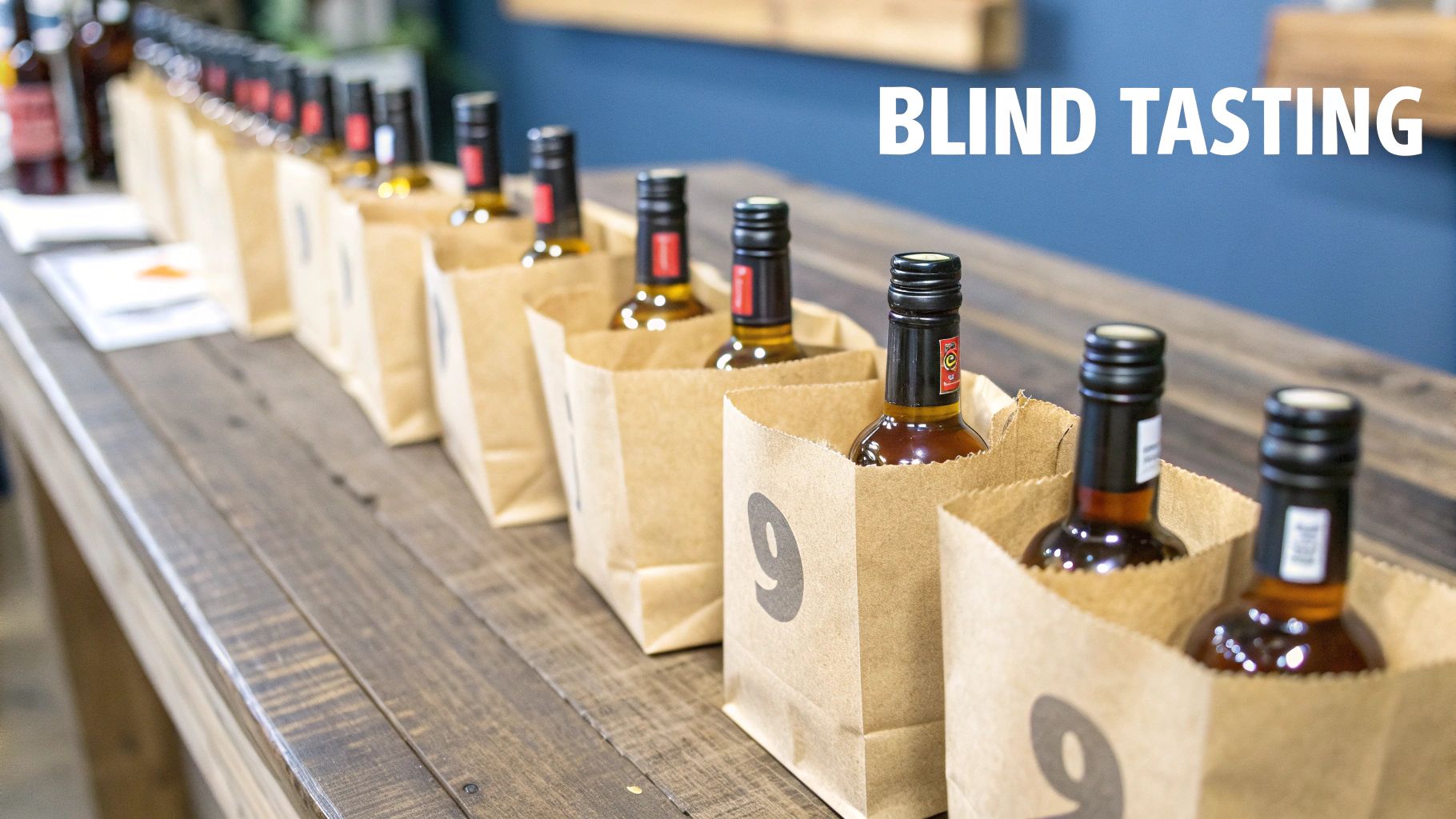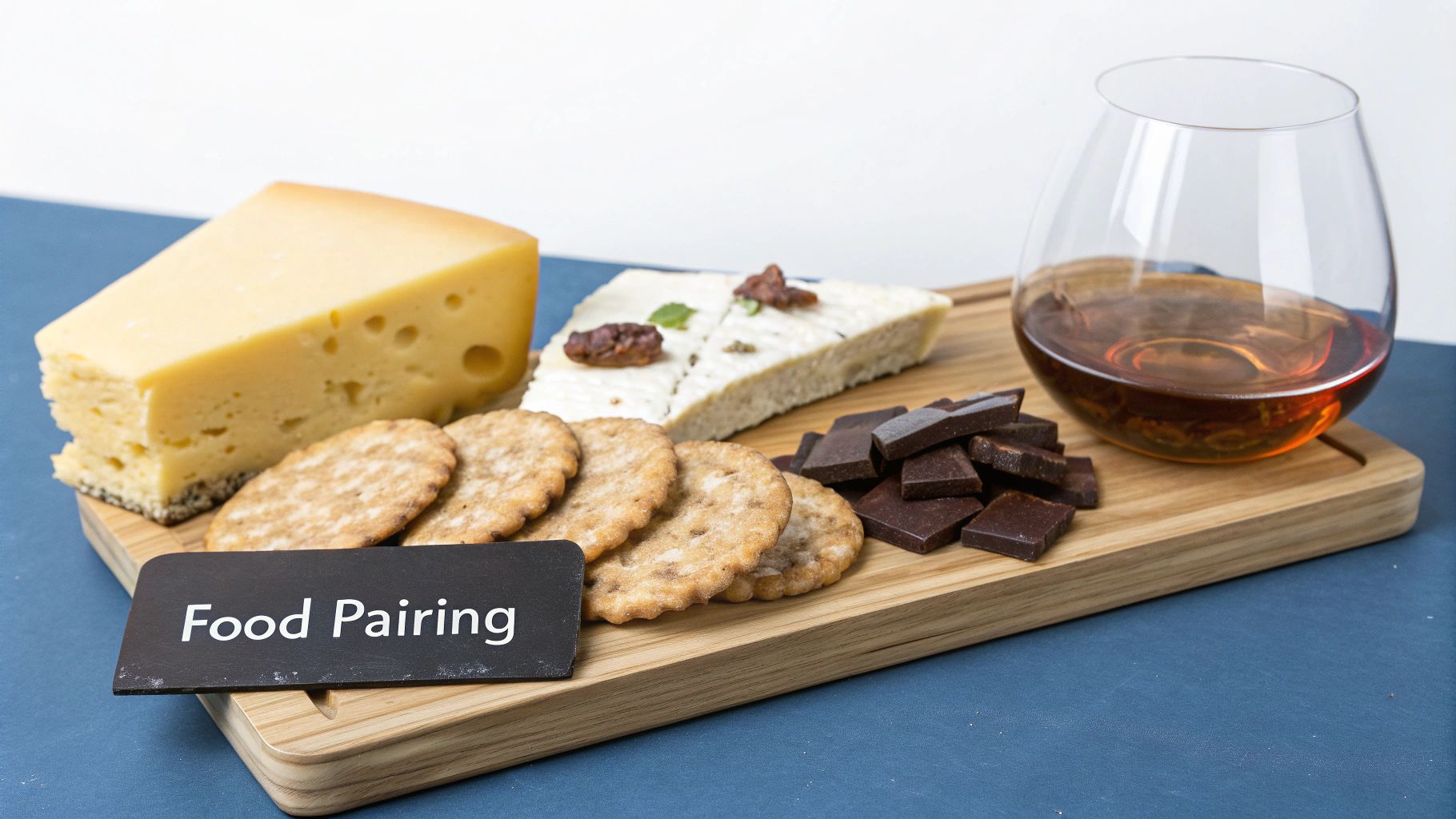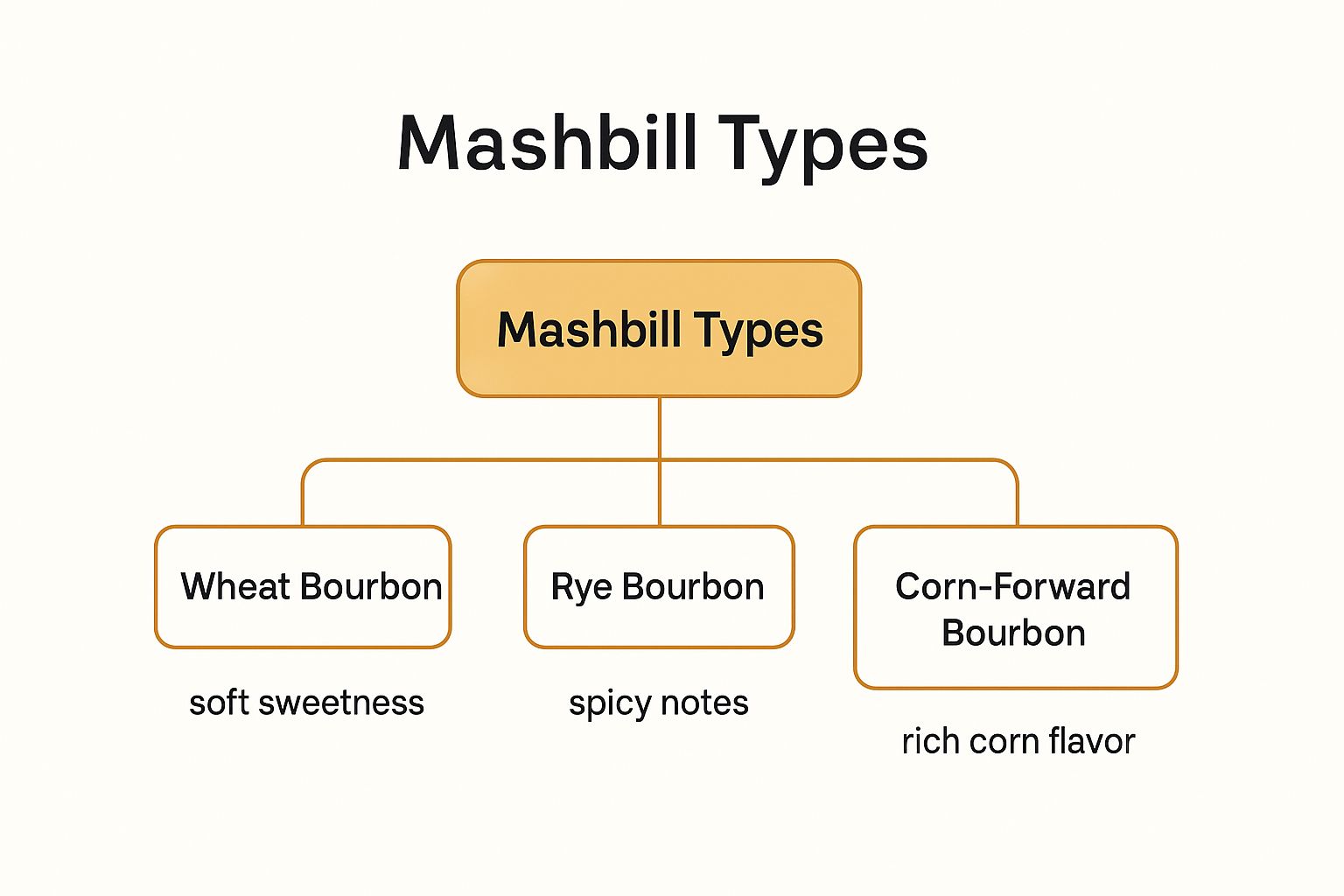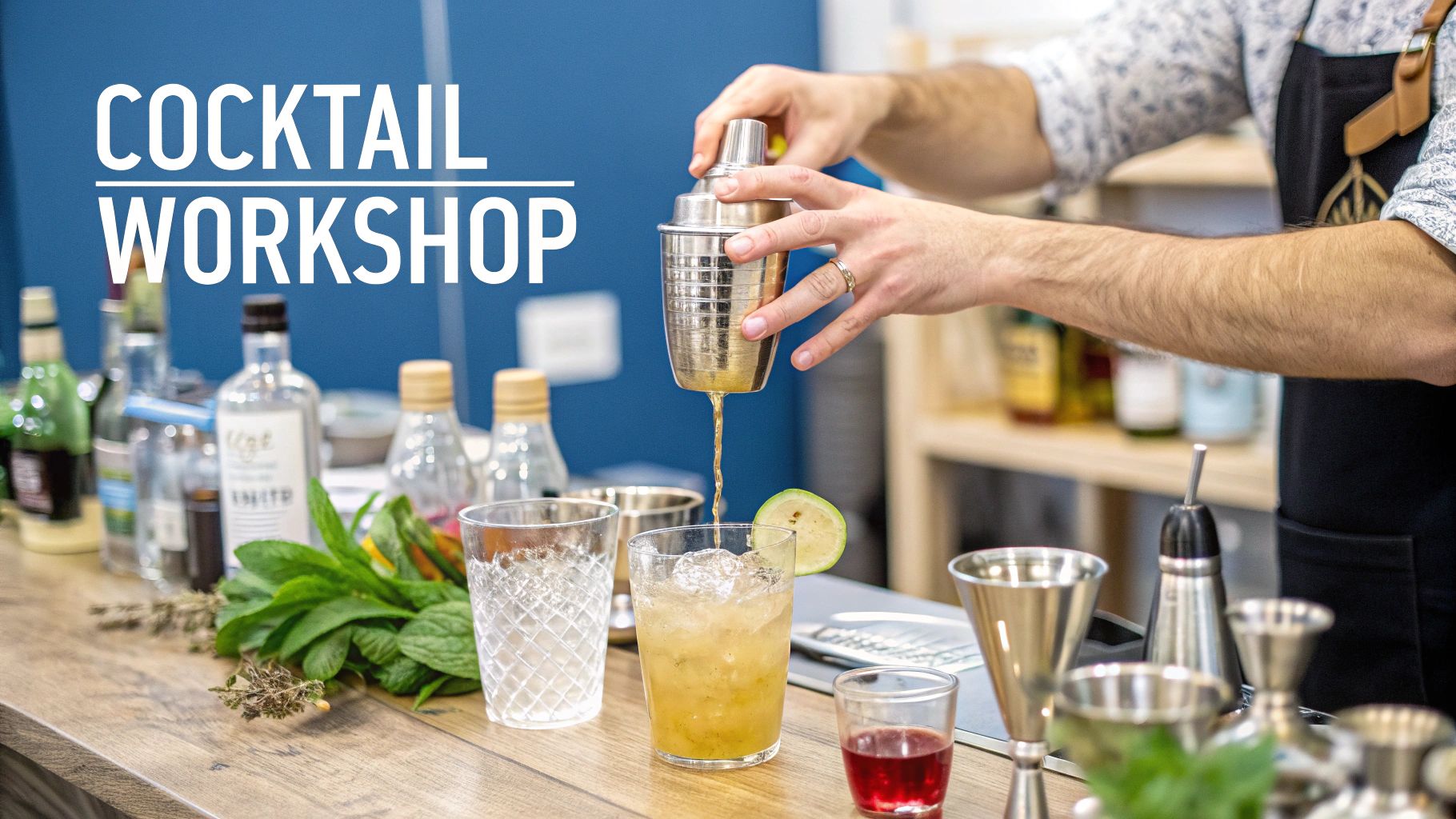Ready to host a bourbon tasting that your friends will talk about for years? Forget just lining up a few bottles and hoping for the best. A truly memorable bourbon tasting party is an experience, a curated journey into the heart of America's native spirit that focuses on exploration, discovery, and shared moments. Whether you're a seasoned enthusiast or introducing friends to the world of whiskey for the first time, the right theme can transform a simple get-together into an engaging event.
This guide offers seven distinct bourbon tasting party ideas designed to educate, entertain, and delight every guest. We'll explore everything from competitive blind tastings that remove brand bias to sophisticated food pairings and interactive cocktail workshops. Each concept is structured to be both approachable for beginners and interesting for seasoned drinkers, featuring tips on selecting unique American craft whiskeys to elevate the experience.
The goal is to move beyond just pouring whiskey and create an interactive, memorable gathering. To truly elevate your bourbon tasting from a simple gathering to a memorable event, focusing on engaging your guests is key. Discover additional tips on making your party fun to ensure everyone has a fantastic time. Let's dive into the themes that will make your next hosting endeavor a smashing success.
1. The Ultimate Challenge: A Blind Tasting Competition
A blind tasting competition is one of the most engaging and educational bourbon tasting party ideas you can host. The premise is simple: conceal the identities of several bourbons to remove any preconceived notions or brand bias. This approach encourages guests, from newcomers to seasoned connoisseurs, to rely solely on their senses to evaluate each pour. The big reveal at the end often uncovers surprising truths about personal preferences versus marketing prestige.

Why It's a Great Idea
This format levels the playing field, making it fun for everyone. A guest new to whiskey might correctly identify a complex flavor note, while an expert might be surprised to find their favorite in the lineup isn't their top pick for the night. It strips away the hype and focuses entirely on the quality and character of the whiskey itself, fostering genuine discussion and discovery.
How to Set It Up
Executing a successful blind tasting is all about preparation. Follow these steps for a flawless event:
- Conceal the Bottles: The most crucial step is ensuring the bottles are truly anonymous. You can use numbered paper bags, specialty bottle socks, or even decant the bourbon into identical, numbered carafes. For a polished touch, consider creating custom, numbered professional bottle labels to mask the original branding effectively.
- Curate a Diverse Flight: Select 4-6 different bourbons. Include a variety of mashbills (wheated, high-rye, traditional) and price points ($30-$100) to create a dynamic tasting experience. Consider adding a standout American craft whiskey from a distillery like Garrison Brothers or FEW Spirits to introduce guests to smaller, innovative producers.
- Provide Tasting Tools: Equip each guest with a scorecard to rate each numbered sample on its Appearance, Nose, Palate, and Finish. Simple 1-10 scales work perfectly. Also, provide palate cleansers like plain water crackers and glasses of water. For new drinkers, suggest they smell the whiskey with their mouth slightly open to avoid being overwhelmed by alcohol vapors.
- Simplify with a Kit: For a truly effortless setup, a pre-packaged solution like the Blind Barrels tasting kit is an excellent choice. These kits provide curated craft whiskey samples, a tasting mat, and a scoring game, removing all the guesswork for the host. You can learn more about how a blind whiskey tasting kit can elevate your party.
2. Regional Bourbon Flight Journey
Take your guests on a geographical tour without ever leaving your home with a Regional Bourbon Flight Journey. This tasting theme is built around the idea that "terroir" isn't just for wine. It explores how a bourbon's character is shaped by its origin, highlighting the subtle and significant differences created by local water sources, aging climates, and distilling traditions across Kentucky's famous bourbon regions.
Why It's a Great Idea
A regional tasting adds a rich, educational layer to your party, turning it into a storytelling experience. Guests will gain a deeper appreciation for the spirit by learning about the history and unique production methods of iconic bourbon hubs like Bardstown ("The Bourbon Capital of the World") and Frankfort. It’s an immersive theme that connects the flavors in the glass to the rich heritage of Kentucky.
How to Set It Up
Transporting your guests to the heart of bourbon country is all about creating an authentic atmosphere. Here’s how to plan your regional tour:
- Select Bourbons by Region: Choose 4-5 bourbons, each from a distinct Kentucky region, to showcase a spectrum of styles. For instance, you could feature Buffalo Trace (Frankfort), Heaven Hill (Bardstown), Wild Turkey (Lawrenceburg), and Old Forester (Louisville). To add a modern twist, include an American craft whiskey from a rising Kentucky distillery like Green River Distilling Co. to show how the traditions are evolving.
- Create a Geographic Guide: Design placemats or informational cards that feature a map of Kentucky's bourbon trail. Mark each distillery's location and include a few key facts about the region, such as its famous limestone water or historical significance. This visual aid makes the tasting more interactive and informative.
- Share Distiller Stories: For each bourbon poured, share a brief history of the distillery or an interesting fact about its production. For example, explain how the high-rye mashbill of Wild Turkey from Lawrenceburg gives it a characteristic spice. This is especially helpful for new drinkers to connect a story to a flavor.
- Enhance the Atmosphere: Immerse your guests in Kentucky culture. Create a playlist of bluegrass music, display photos of the distilleries you're featuring, and consider pairing the bourbons with classic Kentucky-inspired foods like mini Hot Browns, Derby pie bites, or a hearty burgoo. You can explore how to structure this kind of comparative tasting and learn more about crafting the perfect whiskey flight for your event.
3. Bourbon and Food Pairing Experience
A bourbon and food pairing experience elevates a simple tasting into a sophisticated culinary event. This approach treats bourbon like a fine wine, matching different expressions with complementary foods to enhance the flavors of both the spirit and the cuisine. Guests discover how specific tastes interact, creating a memorable and educational journey for their palates. It’s a fantastic way to explore bourbon’s versatility beyond the glass.

Why It's a Great Idea
This theme is perfect for foodies and whiskey lovers alike, offering a multi-sensory experience that is both engaging and delicious. It demonstrates the complexity of bourbon in a tangible way, making it an approachable concept even for new whiskey drinkers. By guiding guests through curated pairings, you can highlight the unique character of different American craft whiskeys and showcase how they can be integrated into a dining experience.
How to Set It Up
A successful food pairing event hinges on thoughtful combinations and clear presentation. Follow these steps to create an unforgettable tasting:
- Select a Bourbon Flight: Choose 3-5 bourbons with distinct profiles. For example, include a soft, wheated bourbon (like Maker's Mark), a spicy high-rye option, and a rich, barrel-proof bourbon. Including an innovative American craft whiskey, such as a four-grain bourbon from Laws Whiskey House, can introduce your guests to something new and exciting.
-
Create Complementary Pairings: Design small bites that either complement or contrast with each bourbon's flavor profile. For an in-depth guide, explore the art of pairing food with whiskey. A few classic ideas include:
- Wheated Bourbon: Pair with creamy desserts like crème brûlée or dark chocolate truffles.
- High-Rye Bourbon: Match its spice with sharp cheddar, spicy charcuterie, or smoked salmon.
- Barrel-Proof Bourbon: Serve alongside rich, fatty foods like brisket sliders or pork belly bites.
- Provide Pairing Cards: For each station, create a small card explaining the bourbon and why its specific food pairing works. This adds an educational element and helps guide guests through the tasting notes.
- Structure the Flow: Arrange the pairings from lightest to richest. Start with lower-proof, sweeter bourbons and their corresponding bites before moving on to the more robust, high-proof expressions to avoid overwhelming the palate early on. This tip is especially important for new whiskey drinkers.
4. Old vs. New Bourbon Showdown
An "Old vs. New Bourbon Showdown" is a fascinating comparative tasting idea that pits classic, established brands against innovative craft distilleries. This theme invites guests to explore the evolution of American whiskey, comparing traditional flavor profiles shaped by decades of history with the bold, experimental approaches of modern producers. It's a journey through time, tasting the heritage and the future of bourbon side-by-side.

Why It's a Great Idea
This theme is perfect for sparking conversation and educating palates on the diversity within the bourbon category. Guests can discuss how distillation techniques, grain recipes, and aging philosophies have changed over time. It’s an engaging way to appreciate the foundations laid by heritage distilleries while discovering the exciting new directions being forged by today's craft whiskey artisans.
How to Set It Up
To host a compelling showdown, focus on creating thoughtful pairings that highlight key differences and similarities.
- Select Strategic Pairings: Create 2-4 pairs, with each including one "old" and one "new" bourbon. Aim for contrast. For example, pair a pre-Prohibition icon like Old Forester against a modern American craft distillery that makes its own whiskey, such as New Riff. Another great matchup is a classic like Wild Turkey 101 versus a contemporary Bottled-in-Bond from Frey Ranch.
- Provide Context and History: Create small cards or a handout for each pairing. Include the founding date of each distillery and a few key facts. Explain terms like NDP (Non-Distilling Producer) to help guests understand that some newer brands source their whiskey, while others distill it themselves. This context enriches the tasting experience.
- Discuss Production Philosophies: Guide the conversation around the differences. Talk about how heritage brands prioritize consistency, while many craft distillers focus on innovation, unique grain bills, or experimental barrel finishes. For instance, compare a traditional Woodford Reserve Double Oaked to a finished craft product like a Barrell Bourbon batch to showcase this contrast.
- Keep the Focus on Discovery: Emphasize that this isn't about which is "better," but about appreciating the different styles. This is a great tip for new drinkers: focus on what you like, not what you're "supposed" to like. Both heritage and craft bourbons offer exceptional quality, and this format helps guests identify what they enjoy about each approach. It’s one of the most educational bourbon tasting party ideas for a curious group.
5. Proof Point Progressive Tasting
A Proof Point Progressive Tasting is a curated journey through the world of alcohol content, offering a fascinating look at how proof shapes a bourbon's character. This structured approach involves arranging several bourbons in ascending order of their alcohol by volume (ABV), or proof. Guests start with smoother, lower-proof expressions and gradually work their way up to bold, high-octane barrel-proof whiskeys.
This method is one of the most educational bourbon tasting party ideas, as it vividly demonstrates the impact of proof on aroma, flavor intensity, and mouthfeel. It’s an eye-opening experience that helps drinkers understand their own proof preferences and learn how to properly approach more potent spirits.
Why It's a Great Idea
This theme demystifies high-proof bourbon and makes it more approachable for everyone. Guests learn that "hot" or "intense" doesn't mean "bad," it just requires a different tasting technique. It’s a sensory experiment that highlights how a distillery's character can transform at different strengths, building confidence and appreciation in both new and experienced drinkers.
How to Set It Up
A progressive tasting is all about careful curation and education. Set your guests up for success with this framework:
- Select a Cohesive Flight: Choose 3-4 bourbons, ideally from the same distillery or with a similar mashbill, to isolate the variable of proof. A great example is starting with Buffalo Trace (90 proof), moving to Eagle Rare 10-Year (90 proof but with more age), and finishing with a powerhouse like Stagg (often 125+ proof). Another excellent progression is Elijah Craig Small Batch (94 proof) followed by its high-octane sibling, Elijah Craig Barrel Proof (120-140 proof).
- Equip for Dilution: High-proof bourbons can be intense. Provide each guest with a small pitcher of cool water and a dropper or pipette. This is a fantastic tip for new whiskey drinkers: show them how adding a few drops of water can "open up" the whiskey, taming the alcohol burn and revealing deeper, more complex flavors.
- Teach Proper Technique: Guide your guests on how to taste high-proof whiskey. Explain the "Kentucky Chew," a technique of swishing a small sip around the mouth to coat the palate before swallowing. This acclimates the senses to the higher alcohol content. For the strongest pours, encourage guests to nose them gently first.
- Control the Pours: Safety and enjoyment are paramount. Pour smaller samples for the high-proof expressions, around 0.5 to 0.75 ounces is plenty. Always remind guests to drink responsibly and have plenty of water and palate-cleansing crackers available.
6. A Deep Dive: The Mashbill Comparison Tasting
A mashbill comparison is one of the most educational and palate-expanding bourbon tasting party ideas, perfect for turning casual fans into informed enthusiasts. The concept is to explore how a bourbon's grain recipe dictates its core flavor profile. By tasting bourbons with different primary flavoring grains side-by-side, guests learn to identify the spicy kick of rye, the gentle sweetness of wheat, and the classic character of a traditional, corn-forward bourbon.
Why It's a Great Idea
This theme demystifies why bourbons can taste so different from one another. It's an interactive lesson in a glass, teaching guests the fundamentals of bourbon production in a tangible way. By understanding the mashbill, participants gain a deeper appreciation for the distiller's craft and can better identify what they truly enjoy in a whiskey, making them more confident consumers.
How to Set It Up
Setting up a mashbill tasting is all about clear curation and education. Guide your guests through the flavors with these steps:
-
Curate a Diverse Flight: Select at least one bottle from each of the three main categories. For example:
- Wheated: Maker's Mark or Larceny. For a craft option, look for Wyoming Whiskey.
- High-Rye: Bulleit Bourbon or Four Roses Single Barrel. A great American craft example is New Riff Straight Bourbon.
- Traditional/Balanced: Buffalo Trace or Evan Williams.
- Provide Educational Aids: Create small cards for each bourbon detailing its specific mashbill percentages (or at least its category). A simple chart explaining the typical flavor contribution of each grain (corn = sweet, rye = spicy/peppery, wheat = soft/bready, barley = malty) is also incredibly helpful.
- Structure the Tasting: Guide guests to taste the wheated bourbon first, as its softer profile won't overwhelm the palate. Then move to the traditional bourbon, and finish with the bold, spicy high-rye expression. This progression is a great tip for new drinkers as it eases them into more intense flavors.
- Include Sensory Elements: For a truly immersive experience, provide small bowls of the actual grains (corn, rye, wheat, malted barley) for guests to see, touch, and smell. This tactile element creates a powerful connection between the raw ingredient and the finished spirit.
This concept map visualizes the direct relationship between the primary flavoring grain in a bourbon's mashbill and its resulting flavor profile.

As the infographic illustrates, the choice between wheat and rye as the secondary grain creates two distinct and divergent paths for the bourbon's character.
7. Bourbon Cocktail Workshop Party
Transform your gathering into an interactive mixology class with a bourbon cocktail workshop. This hands-on party idea moves beyond neat tasting by teaching guests how to craft classic cocktails, demonstrating how different bourbons behave when mixed. Participants first sample bourbons on their own and then use them in iconic drinks like an Old Fashioned or Whiskey Sour, gaining a deeper appreciation for the spirit's versatility.

Why It's a Great Idea
A cocktail workshop is engaging, educational, and perfect for a mixed crowd of bourbon beginners and enthusiasts. It provides a practical skill, allowing guests to leave with the confidence to recreate their favorite bourbon cocktails at home. This format encourages creativity and social interaction as guests share their unique creations and discover which mashbills they prefer in different drinks.
How to Set It Up
A successful workshop requires organized stations and clear guidance. Here’s how to create an unforgettable mixology experience:
- Select Versatile Bourbons: Choose 2-3 bourbons to compare. Start with a foundational, all-purpose bourbon like Buffalo Trace, then add a high-rye option and a wheated bourbon to show how the mashbill impacts the cocktail's final profile. Including a high-proof American craft whiskey like Still Austin 'The Musician' is a great way to show how it can stand up boldly to dilution from ice and mixers.
- Create Cocktail Stations: Set up dedicated areas for each guest or small group. Equip each station with essential bar tools (jigger, mixing glass, bar spoon, shaker), classic glassware, and pre-portioned ingredients. A garnish bar with orange peels, quality cherries, and fresh mint adds a professional touch.
- Provide Clear Instructions: Offer simple, beautifully designed recipe cards for one or two classic cocktails. Start with a neat tasting of the selected bourbons, then guide guests through the cocktail-making process step by step, explaining key techniques like proper stirring and shaking.
- Build a "DIY" Bar: For a more relaxed approach, set up a "Build Your Own Old Fashioned" bar. This is a perfect starting point for new whiskey drinkers. Provide a base bourbon alongside various sweeteners (demerara syrup, maple syrup) and a selection of aromatic and orange bitters. This allows guests to experiment and craft a drink perfectly suited to their palate.
7 Bourbon Tasting Party Ideas Comparison
| Item | Implementation Complexity | Resource Requirements | Expected Outcomes | Ideal Use Cases | Key Advantages |
|---|---|---|---|---|---|
| Blind Tasting Competition | Moderate; requires bottle concealment | Moderate; 4-6 bourbons, scorecards | Objective evaluation; surprising discoveries | Groups 6-12, unbiased tasting | Removes brand bias; educational; engaging |
| Regional Bourbon Flight Journey | Moderate; research on regions needed | Moderate; regional bourbons, food | Educational on terroir and heritage | Groups 8-15, cultural tastings | Builds appreciation for bourbon geography |
| Bourbon and Food Pairing Experience | High; multi-course food prep | High; bourbons plus food ingredients | Sophisticated culinary experience | Groups 6-10, refined palate | Enhances flavors; sociable; approachable |
| Old vs. New Bourbon Showdown | Moderate; sourcing contrasting brands | Moderate; diverse bourbons | Insight into tradition vs. innovation | Groups 8-12, comparative tasting | Highlights bourbon evolution; sparks debate |
| Proof Point Progressive Tasting | Moderate; arranging by proof levels | Moderate; bourbons with varying proofs | Understanding proof impact on flavor | Groups 6-10, technical tasting | Logical progression; teaches tasting skills |
| Mashbill Comparison Tasting | Moderate; research on mashbills | Moderate; bourbons by mashbill type | Educates on grain impact on flavor profile | Groups 8-15, educational tasting | Develops palate skills; clear flavor focus |
| Bourbon Cocktail Workshop Party | High; requires cocktail equipment | High; bourbons, cocktail ingredients | Interactive skill-building and tasting | Groups 6-12, social/interactive | Engaging; practical skills; creative |
Your Perfect Pour Awaits
Hosting a memorable bourbon tasting is far more than just pouring a few glasses of whiskey. It's about crafting an immersive experience that ignites curiosity, sparks conversation, and deepens appreciation for America's native spirit. Throughout this guide, we've explored a variety of dynamic bourbon tasting party ideas, each designed to offer a unique lens through which to view this complex spirit.
From the competitive thrill of a blind tasting competition to the geographical storytelling of a regional flight journey, you now have a versatile toolkit at your disposal. You can dive deep into the science of spirits with a mashbill comparison or a proof point progression, or you can explore the culinary chemistry of a meticulously planned food pairing. The key is to select an approach that aligns with your hosting style and your guests' level of expertise, whether they are seasoned connoisseurs or brand-new to the world of whiskey.
Key Takeaways for Your Next Bourbon Event
The most successful tasting parties are built on a foundation of thoughtful planning and engaging execution. Remember these core principles as you plan your event:
- Structure is Your Friend: A well-defined theme, like an Old vs. New Showdown or a Cocktail Workshop, provides a clear narrative for your event. This structure guides your guests through the tasting, making the experience more educational and less overwhelming, especially for newcomers.
- Encourage Active Participation: The best events are interactive. Whether it's through tasting notes, guessing games, or hands-on cocktail making, giving your guests a role to play transforms them from passive observers into active participants. This is what creates lasting memories.
- Details Matter: From providing the right glassware and palate cleansers to curating a complementary playlist, small details elevate the entire experience. These thoughtful touches show your guests you've considered their comfort and enjoyment from start to finish.
Your Actionable Next Steps
Feeling inspired? It's time to put these ideas into action. Start by choosing one theme from this list that genuinely excites you. Begin your research by selecting three to four bourbons that fit your chosen concept, focusing on variety. Don't be afraid to feature lesser-known American craft whiskeys from distilleries like Frey Ranch or Southern Star to introduce your friends to something new.
Once your theme and bourbons are set, build the rest of your party around them. Plan your food pairings, gather your tasting materials, and create a simple agenda for the evening. By breaking down the process, you can confidently host a sophisticated and entertaining bourbon tasting that your guests will be talking about long after the last drop is savored. Ultimately, the goal is to create a welcoming space for discovery and shared enjoyment.
Ready to host an unforgettable tasting with minimal prep? Let Blind Barrels do the curating for you with a blind tasting kit delivered right to your door, featuring incredible American craft whiskeys. Explore our tasting experiences and make your next party a guaranteed hit at Blind Barrels.
